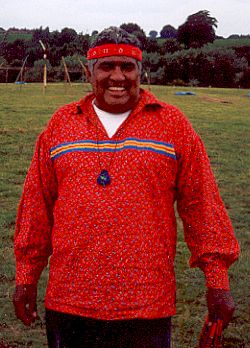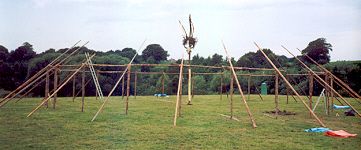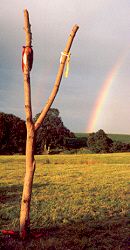 |
 |
Benito
Rael is a Native American of Tiwa and Southern Ute decent whose
father was a Picuris holy man. He is a carrier of the teachings of his
brother Beautiful Painted Arrow, Joseph Rael. The following interview
was conducted before the Sun-moon dance held in Manchester during July
2000 at which Benito Rael was the dance Chief.
The Sun-moon dance
lasts for a period of four days in which participants dance backwards
and forwards to a ceremonial tree in the centre of an Arbour. During
this period they abstain from food and water. This is spiritual
ceremony.
|
Joseph Rael in his
book “Ceremonies of the Living Spirit” says:
'I don’t teach
Picuris (Tiwa) religion or Ute religion. I teach what has come to me
from my visions. I spent fifty years becoming a visionary, so that what
I do in ceremony comes from the Source and it works. I don’t know how
these ceremonies work or why they work, but they work. People who
criticize me for sharing ceremonies with non-Indians don’t understand
that the ceremonies I am doing are not traditional or tribal.'
'I believe that
this is a way of bringing people who really want to know the Spirit
into the context of the Spirit, so that they will know their own inner
source and how to bring that forth in their lives in an active way and
awaken their own spiritual awareness.'
To see or buy
copies of Joseph Rael's books please go Amazon.com
Interview note:
Sometimes the
Native American way of answering a question can be to take you round in
a circle before the answer is reached. This in a sense communicates
with you on other levels. So when reading this interview you may find
it beneficial to try and in some way absorb the answers rather than
dissect them.
(Photos
are taken before or after the Sun-moon dance in Manchester year 2000.)
Can you explain
something about ceremony for those who haven't come across it before?
 The
thing about ceremony is, you need to want to better your life.
The
thing about ceremony is, you need to want to better your life.
In my brothers
books he states - and what I was taught when I was growing up - that
‘work is worship’. In Picuris where I was raised, just to go out and
irrigate your fields, or hoeing, or raising food we see as spiritual
endeavors. This work for us is worship. So when you do a dance, the
effort that you place in the dance, whether it be a Drum dance, Long
dance, or whatever, the effort that you put in, you get out of it. If
you have some issues that you want to work with, you work with those
issues in the dance. You make your path forward or backwards. A lot of
people go to the dance saying I've got a lot of trouble in this area or
that area and they want to make them right.
When you've
decided to do a dance it's commitment. And when you decide you want to
do something you commit to it just like you do in a job. You say I want
to do a Sun-moon dance. I'm going to commit myself for four years. And
then when you reach that four your going to say “gee whiz”, so you
might decide to make another commitment. What you are doing every year
is you're taking your brain and what you've learned to the dance and
enhance that learning process in the dance and like I said ‘work is
worship’.
You give up your
food and you give up your water- you've made a commitment to do this.
Many years ago
when the non-Indian heard about this way of worship they said, “What’s
the trade?” - “Why are you dancing to this tree?” or, “Why are they
dancing to this line of feathers”, or “Why do they do what they're
doing?”
A priest asked me
once, “What is it in that tree?”
I compared it to
his ceremonies. I said, “What is it sitting at that altar and going to
church and getting calluses on your knees?”
He said, “Don't
you talk about it like that!”
And I said, “Well,
what are you doing to me?”
I said, “When I go
and do ceremony it is done in a manner that I know. Many years ago my
Dad said there are so many directions you can go - you've got a sister
who is a Methodist, a mother who’s baptized Catholic and a brother
who’s Pentecostal, and another brother that’s a Mormon and they all
chose what they wanted to do. And he said, “Son, one of these days
you're going to have to choose the kind of work you want to do.”
And what I'd seen
in that vision when I was 15 years old **, that’s when I was told what
I'm going to do. Now that I have been brought into this way of life I
realize what that vision was. When you dance to that tree, that tree is
the tree of life, that tree is a symbol that we use for dance, just as
churches have symbols or procedures that you have to follow. It’s the
same thing, it’s just a different way to believe and to bring yourself
to spiritual life. And in this way, in a pure way, we worship.
(** When Benito
was 15 years old he had a vision of many bad spirits and animals
closing in on him from the side, and the only way out of this was to
pull a piece of string that hung from the roof. When he pulled the
string he was taken to the spiritual realms.)

To a lot of people
this may seem a bit backward - a bit simple. People might be thinking
you are missing the point or something. Can you explain to someone with
these views?
There are
different ways of making yourself right with the higher power. Some
kneel for hours and hours because it is really good - and it’s the same
thing as dancing until you wear down. That discipline always has a
factor in how you do the dance. That discipline you learn from your
parents.
They imposed
religion on us. And you think “gee whiz” they were trying to take away
our belief because it wasn't their way and they didn't understand it. A
lot of it has to do with if you can understand this way. A lot of
people say I don’t know how you can do what you do and receive
spiritual light. So a lot of people need to experience this for
themselves.
 If
you get a person and set them out in the middle of nowhere and there’s
no means of food or water who do you think they turn to? That’s where
this comes from.
If
you get a person and set them out in the middle of nowhere and there’s
no means of food or water who do you think they turn to? That’s where
this comes from.
When you've
reached that last bit of water and you are wondering where the rest is
going to come from, then you come to realize that without the guy up
stairs, Great Spirit, Wah Mah Chi, God, or whatever you want to call
it, you wouldn't be where you are today because he’s the only one who
gives us this divine calling as you would say.
So, it’s all a
matter of preference. Some people don’t understand it at first. So my
brother wrote his books so they could read and he could explain what
all this stuff is. So therefore when the time comes to right your way
of believing you can use the dance. It doesn't have to be a Sun-moon
dance or a Long dance or a Drum dance. You can give thanks through many
different dances. The way I was raised the animals were our bothers,
and we protect them, and in return they give themselves to us. They
were gifts. So sometimes we do animal dances.
We are all raised
in a society where things are cut and dried - this is what you believe
in and that is it, and there is no other avenue. A lot of people who do
this work are the clergy. I've had clergy come. They say I'm father
so-and-so, I'm sister so-and-so, and I'm Reverend so-and-so.
I say, “Well what
are you doing here? You don’t need this dance.”
They have said,
“No, but there’s something in there as far as discipline is concerned.
I need discipline to go out and teach my congregation. I need the
discipline it takes to confront my daily endeavors because I was taught
this stuff here but I was never taught the discipline it takes, that I
receive from this kind of dance.”
We have preachers
and lawyers and people of high standing that are doing this work
because they've come to a point where the way they were brought up and
taught is not exactly what they want. So they're looking for something
different. This is something they do for themselves for their own
spiritual strength.
How would you
define ceremony? How would you say to people what ceremony is?
It’s like that
festival that is on in Holland right now. They are having a Revival
that is lasting four days or a week or so. People go there and have a
Revival. That’s what you could say this could be. It’s a Revival for
you to make yourself right in you.
You could say “I'm
going to a Native American ‘traditional / non-traditional’ Revival
where everyone can participate if they want to. And maybe they fast and
through prayer they receive.
The Native
Americans, the South Americans and the Greeks used to do it and they
just got away from it. Christianity changed a lot how we perceive this.
If they would have understood it many years ago then it would have been
different. If they'd have understood it then maybe there'd be more
people interested in it. Interest comes with the knowledge. Like I
said, my brother wrote those books to give the knowledge to the world
and through that people have dedicated their lives to this kind of
work.
Because this is a
non-traditional dance people don’t have to feel excluded?
Everyone who wants
to enhance their way of believing can do it this way because there is
no certain set pattern, you just go to an Arbour and you do it in a
circle of light and you do it in a line, to where you can focus on what
you want. That’s what the dance is about - focus and making a
commitment.